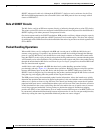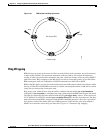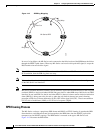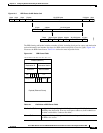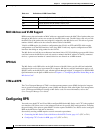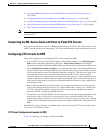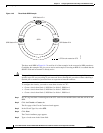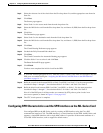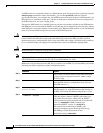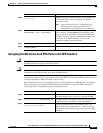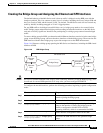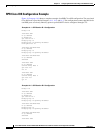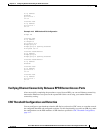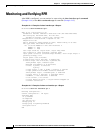
14-9
Cisco ONS 15310-CL and Cisco ONS 15310-MA Ethernet Card Software Feature and Configuration Guide R8.5
78-18133-01
Chapter 14 Configuring Resilient Packet Ring on the ML-Series Card
Configuring RPR
Step 6 Select the relevant size of the circuit from the Size drop-down list, and the appropriate state from the
State list.
Step 7 Click Next.
The Source page appears.
Step 8 Select Node 1 as the source node from the node drop-down list.
Step 9 Select the ML-Series card from the Slot drop-down list, and choose 0 (POS) from the Port drop-down
list.
Step 10 Click Next.
The Destination page appears.
Step 11 Select Node 2 as the destination node from the Node drop-down list.
Step 12 Select the ML-Series card from the Slot drop-down list, and choose 1 (POS) from the Port drop-down
list.
Step 13 Click Next.
The Circuit Routing Preferences page appears.
Step 14 Uncheck the Fully Protected Path check box.
Step 15 Click Next.
The Circuit Constraints for Automatic Routing page appears.
Step 16 Click the Node 1 icon to select it and click Next.
The Route Review/Edit page appears.
Step 17 Click Finish.
You have now completed the initial circuit for the RPR.
Note A TPTFAIL alarm might appear on CTC when the circuit is created. This alarm will disappear after the
POS ports are enabled during the “Assigning the ML-Series Card POS Ports to the SPR Interface”
procedure on page 14-11.
Step 18 Build the second circuit between POS 0 on Node 2 and POS 1 on Node 3. Use the same procedure
described in Steps 1 through 17, but substitute Node 2 for Node 1 and Node 3 for Node 2.
Step 19 Build the third circuit between POS 0 on Node 3 and POS 1 on Node 1. Use the same procedure
described in Steps 1 through 17, but substitute Node 3 for Node 1 and Node 1 for Node 2.
Now all of the POS ports in all three nodes are connected by STS point-to-point circuits in an
east-to-west pattern, as shown in Figure 14-5 on page 14-8.
Step 20 The CTC circuit process is complete.
Configuring RPR Characteristics and the SPR Interface on the ML-Series Card
You configure RPR on the ML-Series cards by creating an SPR interface using the Cisco IOS
command-line interface (CLI). The SPR interface is a virtual interface for the SPR. An ML-Series card
supports a single SPR interface with a single MAC address. It provides all the normal attributes of a
Cisco IOS virtual interface, such as support for default routes.




